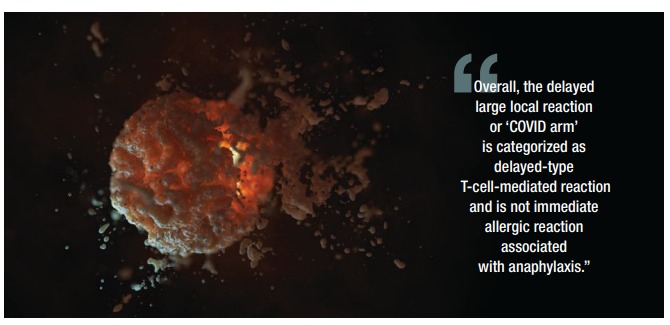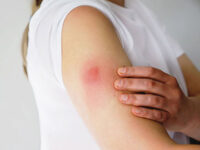Sara Anvari, MD, MSc, FAAAAI, with Lisette Hilton

Patients vaccinated with the mRNA-1273 SARS-CoV-2 vaccine (Moderna) can potentially develop large local reactions approximately 1 week after vaccination. Findings at the injection site include erythema, induration, and tenderness. The cutaneous findings have been termed “COVID arm” or “red arms.”
Histopathological biopsies obtained from reaction sites demonstrated superficial perivascular and perifollicular lymphocytic infiltrates with rare eosinophils and scattered mast cells. Immunohistochemical staining revealed CD3+ T cells, with a mixture of CD4+ and CD8+ T cells, as well as few scattered CD20+ B cells. Overall, the biopsy findings are consistent with a delayed-type T-cell-mediated hypersensitivity reaction.
In our reported cohort of 12 patients, individuals were of various ages and sex. The median time to onset for the large local reaction was about 8 days (range 4 to 11 days) following the first injection with the Moderna vaccine. The median time to onset of the large local reaction following the second injection was about 2 days (range 1-3 days). Not all patients experienced a recurrence of delayed local reactions following their second dose. In addition to the large local reaction, 2 patients experienced cutaneous symptoms that were not localized to the injection site. One developed a rash on the palm and fingers; another had a hive-like or urticarial plaque on the elbow.1
As with the mRNA-1273 SARS-CoV-2 vaccine (Moderna), a recent correspondence in the New England Journal of Medicine by Baeck et al described a similar delayed large local reaction following vaccination with the BNT162b2 SARS-CoV-2 vaccine (Pfizer). The patient, a 38-year-old woman, developed redness of the upper arm and numbness of the fingers 6 days after her first vaccine dose. Symptoms resolved within 5 days. The patient received her second vaccine dose without recurrence of the delayed local reaction.2
A delayed-type T-cell-mediated reaction
In reply to the Baeck et al correspondence, Blumenthal, Saff, and Freeman noted that delayed large local reactions could occur with any vaccine; however, these reactions were more common with the mRNA-1273 vaccine (Moderna) than with the BNT162b2 vaccine (Pfizer).3 Data collected and published from a COVID-19 vaccine allergy case registry at Massachusetts General Hospital (MGH) (https://allergyresearch.massgeneral.org) and an international COVID-19 dermatology registry by American Academy of Dermatology and the International League of Dermatologic Societies (www.aad.org/covidregistry) further supported the evidence of large local reaction occurrence following either the Moderna or Pfizer vaccine. Data collected from the MGH allergy case registry between February 10 and March 13, 2021 showed a total of 146 delayed local reaction cases with 95% (n=139) occurring after receiving the Moderna vaccine and 5% (n=7) occurring with Pfizer.4 The dermatology registry reported similar findings with both vaccines.5
Overall, the delayed large local reaction or “COVID arm” is categorized as delayed-type T-cell-mediated reaction and is not immediate allergic reaction associated with anaphylaxis. Severe allergic immediate reactions typically occur within 4 hours following exposure to an allergen, such as a food, drug, or vaccine, and can present with symptoms of hives, swelling, cough, wheeze, shortness of breath, throat swelling, and/or vomiting. The individuals who have reported delayed large local reactions following their COVID vaccine did not experience immediate allergic reactions.
It is important to note that the COVID vaccines work by activating the immune responses to create protection against future exposure from the virus . Patients receiving the SARS-CoV-2 vaccines can experience “flu-like” symptoms, such as myalgia, fever, chills, and headache. These symptoms are part of the immune response—one that we expect to see in an individual following vaccination.

I continue to educate colleagues and patients that delayed large local reactions are rare but can occur after receiving the Moderna or Pfizer vaccine. I also provide reassurance that delayed local reactions should not prevent someone from receiving the second vaccine dose. To help reduce symptoms associated with the large local reaction, I recommend taking antihistamines for itching, analgesics for pain (ie acetaminophen or nonsteroidal anti-inflammatories), and using cold compresses at the site of injection to help reduce pain and inflammation. I have also suggested using the opposite arm for the second injection.
Registries have been extremely helpful and have allowed us to record data on these types of reactions. Additionally, we will soon be able to obtain more information on other COVID vaccines and whether similar reactions can occur. Overall, delayed large local reactions at the injection site can occur with any vaccine . These reactions are not life-threatening, will resolve, and should not be a reason to avoid vaccination.
References
- Blumenthal KG, Freeman EE, Saff RR, et al. Delayed large local reactions to mRNA-1273 vaccine against SARS-CoV-2. N Engl J Med. 2021 Apr 1;384(13):1273-1277. doi: 10.1056/NEJMc2102131.
- Baeck M, Marot L, Belkhir L. Delayed large local reactions to mRNA vaccines. N Engl J Med. 2021 Apr 21:10.1056/NEJMc2104751#sa1. doi: 10.1056/NEJMc2104751. Online ahead of print.
- Blumenthal KG, Saff RR, Freeman EE. Delayed large local reactions to mRNA vaccines. Reply. N Engl J Med. 2021 Apr 21:10.1056/NEJMc2104751#sa2. doi: 10.1056/NEJMc2104751. Online ahead of print.
- Blumenthal KG, Saff RR, Freeman EE. Delayed large local reactions to mRNA vaccines. Reply. N Engl J Med. 2021 Apr 21:10.1056/NEJMc2104751#sa2. doi: 10.1056/NEJMc2104751. Online ahead of print.
- Blumenthal KG, Saff RR, Freeman EE. Delayed large local reactions to mRNA vaccines. Reply. N Engl J Med. 2021 Apr 21:10.1056/NEJMc2104751#sa2. doi: 10.1056/NEJMc2104751. Online ahead of print.
Disclosures
Dr. Anvari receives grant support from DBV Technologies, NIAID/NIH, and Regeneron.


